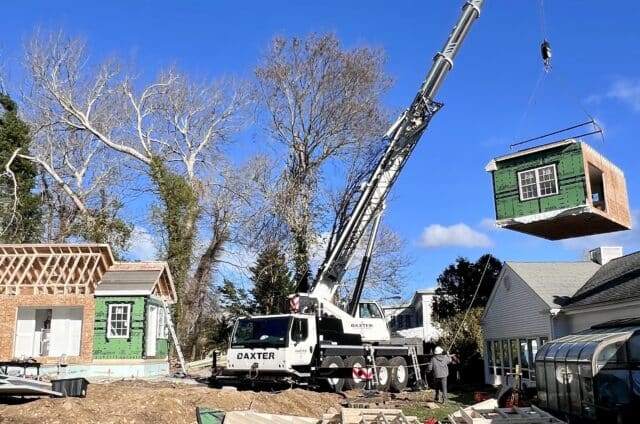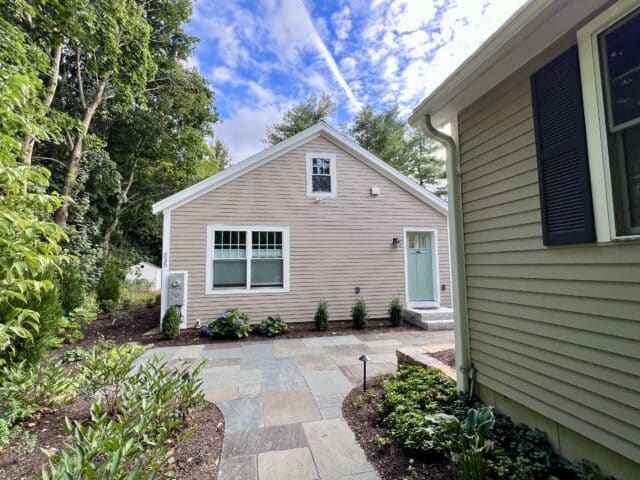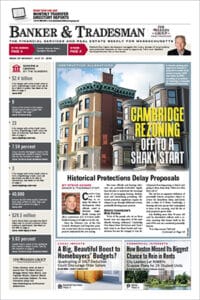
Officials hope the statewide legalization of ADUs on single-family lots will yield up to 10,000 new homes over 10 years. iStock photo illustration
Starting Sunday, accessory dwelling units will be legal on most single-family lots across Massachusetts. Housing advocates are hopeful it could be the start of a meaningful, if small contribution to fixing the state’s housing shortage, but challenges loom.
The Healey administration estimates that the new regulations will let 8,000, to 10,000 ADUs be built over the next 10 years as the state grapples with a 200,000-unit shortage.
One reason for optimism, even as towns and cities still have the option to pass local rules about the size and design of these units: The budding ADU industry isn’t launching from a standing start.
Some local financial institutions already offer construction financing.
Boston-area banks, Leader Bank, Dedham Savings, South Shore Bank, Needham Bank, and The Cooperative Bank of Boston announced a partnership with Boston city officials in November to offer zero-interest loans to low- and moderate-income city homeowners looking to add an accessory dwelling unit to their property.
And The Cooperative Bank of Cape Cod, based in Hyannis, launched its own ADU construction loan product three years ago as advocates started winning zoning changes in towns across the Cape that made ADU construction possible.
Charlotte Green, first vice president and residential mortgage sales manager for the bank, said that the bank fields five to 10 inquiries a week regarding ADU projects.
“There’s tremendous interest here on the Cape and we’ve heard it bubbling up from over the bridge, as well, as people have heard about these changes coming down the line,” she said. “It’s been very popular.”

A construction worker helps guide a modular part of a Backyard ADUs home into place in a backyard in Orleans in December 2024. Photo courtesy of Backyard ADUs
Some construction companies are starting to specialize in the construction of these units. Christopher Lee, head of design and development for Barnstable- and Brunswick, Maine-based Backyard ADUs, said that demand for ADUs has been around for some time, and can be credited to the wave of small-home construction in the West.
“It’s been in response to early adopters seeing what’s going on in California and Oregon and Seattle,” he said. “So, the [Massachusetts] legislation comes in and it kind of helped boost awareness and open the doors for a lot of people that have been looking for ways to house elderly parents or try to make ownership of their own homes more affordable with rental income.”
California Experience Suggests High Demand
California is often cited as a success story when it comes to generating substantial new housing through ADU construction. According to California YIMBY, one of that state’s biggest housing advocacy groups, 19 percent of all housing units produced in California in 2022 were ADUs. The group also said that collectively 83,865 ADUs were permitted in California between 2016 and 2022.
And while many of those permits didn’t immediately translate into new homes, a study released by the Joint Center for Housing Studies of Harvard University found that production of accessory dwelling units in California still spiked after sweeping statewide policy changes like Massachusetts’ in 2016. From 2016 to 2022, the number of ADUs permitted each year increased from 1,269 units to just under 25,000 units.
Data collected by the California Department of Housing and Community Development says that 68,482 new ADUs were built in the state between 2018 and 2023, alone.
In Massachusetts, Lee said, demand is widespread throughout the state but somewhat concentrated in Greater Boston and Cape Cod due to higher number of high-income earners living there. Northampton is another area where Backyard ADUs is constructing these units.
“I think there’s a lot of room in suburbs of larger lots to build homes and those have also been the communities that are traditionally the most exclusive,” said Mike Kriesberg, policy and advocacy manager at advocacy group Abundant Housing MA.” So, it’d be great to see, you know, more housing in those communities.”

An example of Backyard ADUs’ accessory dwelling unit, installed at a property in Concord. While the company has a standard catalogue of designs, buyers can customize them. Photo courtesy of Backyard ADUs
Construction Costs Create Challenges
That doesn’t mean meeting the Healey administration’s ADU production hopes will be without its challenges. Green noted that the price tag on projects can easily rise, causing problems for homeowners when looking for financing.
“There’s no such thing as a cheap, new-construction home anymore,” he said. “So, it takes somebody with a little bit of higher income, or selling a house that they owned outright, to be able to be able to pay for something of any costs that they can build.”
Massachusetts legislators’ choice to limit ADUs to single-family lots, too, could curb how many get built.
While there is also demand from landlords to construct ADUs, according to MassLandlords Executive Director Doug Quattrochi, the regulations make it difficult for anyone who owns a duplex or a three-family home to take advantage.
“If you have more units, you’re more robust to vacancy or non-payments, you just generally are more able to reach scale,” he said. “So, we’d all like to have another unit, but rental property comes in these big chunks. You’ve got to buy three units at a time or four units at a time. That’s historically not the way we’ve added housing – we would build up or build out.”

Sam Minton
Hope for Potential Impact
While more ADUs would help out a state that is desperately in need of additional homes, experts interviewed for this story believe that it is hard to imagine that the new ADU law will make a transformative impact on its own.
“I do think this will make a dent,” said Andrew Mikula, senior housing fellow at the Pioneer Institute. “My personal philosophy is: Scalability is more about being able to replicate housing policy solutions across sites in various neighborhood contexts, as opposed to building a lot of units at once. So in that regard, I think ADUs can be a scalable solution. This is a first step.”
Kriesberg, with Abundant Housing MA, said that there is the potential for ADUs to be a catalyst for a future housing boom.
“The regulations developed by HLC are really strong,” he said. “They really provide a permissive framework that allows homeowners to build an ADU. If we find that municipalities still try every which way to restrict housing production, then the impact will be more limited. But if [towns and cities] follow both the intent and the letter of the law and the regulations published by the legislature and published by HLC, and then even go further to encourage housing production, then I think there’s a lot more potential for housing production.”





